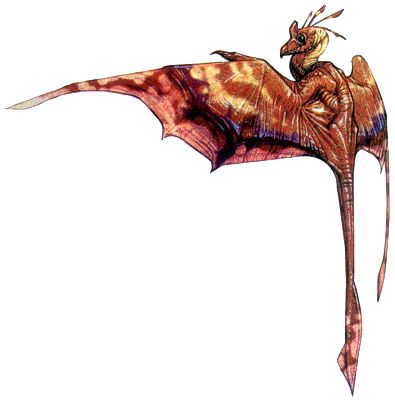

Dragon #272

| Climate/Terrain: | Tropical jungle |
|---|---|
| Frequency: | Rare |
| Organization: | Family unit |
| Activity Cycle: | Day |
| Diet: | Omnivore |
| Intelligence: | Very (11-12) |
| Treasure: | Q×3,P |
| Alignment: | Neutral |
| No. Appearing: | 1-6 |
| Armor Class: | 3 |
| Movement: | 6, fly 24 (B) |
| Hit Dice: | 3 |
| THAC0: | 17 |
| No. of Attacks: | 2 |
| Damage/Attack: | 1-4/1-4 |
| Special Attacks: | Breath weapon, psionics |
| Special Defenses: | Psionics |
| Magic Resistance: | 10% |
| Size: | S (2'-4’ long) |
| Morale: | Elite (13) |
| XP Value: | 650 |
Psionics Summary
| Level | Dis/Sci/Dev | Attack/Defense | Score | PSPs |
|---|---|---|---|---|
| 6 | 3/3/11 | None/MB,MBk,TS | 12 | 45 |
Psychoportation – Science: teleport; Devotion: dimensional door.
Clairsentience – Sciences: clairaudience, clairvoyance; Devotion: all-round vision.
Telepathy – Sciences: nil; Devotions: attraction, aversion, contact, false sensory input, invisibility, life detection.
Pavilion dragons live in the tops of the tallest trees in tropical rainforests. Some people compare them to faerie dragons, colorful tropical birds, or a cross between the two. They have beaklike snouts, large eyes, snaking necks, and four legs close together on their bodies. Their scales resemble gemstones – dark blue like spinel on females and a fiery rainbow of rubies, jacinth, and topaz on males. Their tails are almost as long as the rest of their body, and their wings have long tips that, when folded, drape down alongside the tail. They range in size from about 18” when hatched to 4’ long in extreme old age.
Combat: Pavilion dragons are generally non-aggressive, but they fight fiercely to defend their nests and young from poachers. When threatened, they use their breath weapon first. This weapon is a sharp percussion of sound that stuns all creatures (except other pavilion dragons) within 15’ unless those creatures make a successful saving throw vs. breath weapon. Affected creatures cannot act for 2d4 rounds. Pavilion dragons can use their breath weapon three times a day.
In addition to their breath weapon, pavilion dragons have the psionic powers of 6th-level psionicists. They prefer the disciplines of psychoportation and clairvoyance above others and generally study powers of defense and escape. The powers listed above are common selections, but pavilion dragons have as much flexibility to choose their psionic abilities as any other psionicist character.
As a last resort, a pavilion dragon can attack with two claws as it swoops on opponents. These attacks each cause 1d4 points of damage. If both claw attacks hit, dragonets can carry off a creature of size T or S. They generally use this ability to carry off their prey. When faced with very small enemies like tasloi, however, they carry off their opponents to drop them from a great height.
Habitat/Society: Pavilion dragons build nests in the topmost branches of a rainforest’s tallest trees. They mate for life, and the female lays one egg every spring. The young remain with the parents for five years, forming family units consisting of two adults and as many as five hatchlings.
Pavilion dragons are prized as familiars and companions, though they do not willingly leave their homes. They bond so closely with humanoid companions that they share complete telepathy within a range of 100 yards, transmitting not only sights and sounds but also complete thoughts.
Pavilion dragons are the most even-keeled of all dragonets. They are fun-loving without being annoying, sharing warm humor with their companions. They delight in the natural beauty of their homes more than in pranks.
Ecology: Pavilion dragons eat a wide variety of large insects, small birds, eggs, fruits, and occasionally lizards and small monkeys. They have a natural lifespan of 26-35 years.
